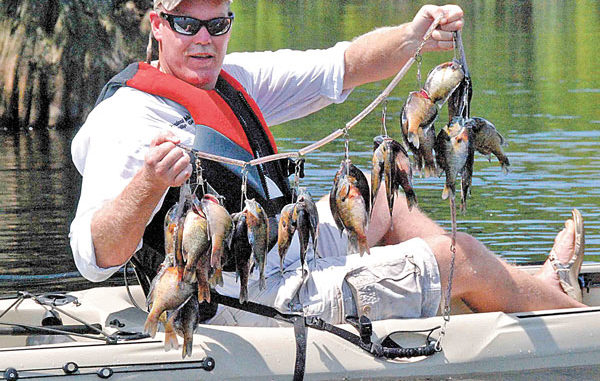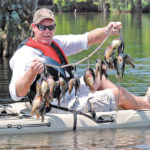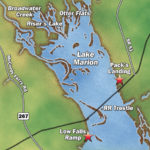
If you’re going to start something, you might as well start at the beginning, so it seems only appropriate that the first column about kayak fishing and hunting adventures in South Carolina should start with a perch-jerking trip since bream were the “first fish” for many of us.
Bream fishing from a kayak is, in a lot of ways, superior to fishing for bream from a conventional boat. I realized this while paddling through the Sparkleberry Swamp with guide Matthew Outlaw. Having grown up in nearby St. Matthews, Outlaw views the 16,000 acres of half-land, half-water wilderness the same way city kids view the old sandlot. He simply grew up in there.
Sparkleberry is a forested mass of tannin-stained blackwater creeks, sloughs and ditches that slip quietly beneath an overhead canopy of cypress and tupelo trees draped with Spanish moss. It’s a breathtakingly beautiful place right up until the moment you lose your bearings, get turned around and realize you’re lost. With today’s modern technology of hand-held GPS — which I double checked and made sure to mark when we launched at Pack’s Landing — the likelihood of getting lost is greatly diminished. Still, I wasn’t going to let Outlaw get too far out of sight, especially since he had all the best bream beds marked in his head anyway.
According to Outlaw, the better areas to try to locate bream beds are not the stereotypical spots where you would expect to find them. This means that that cluster of trees right on the edge of the creek channel that looks like it’s loaded with bream may hold a fish or two, but not the numbers he normally likes to find. He said he has much more success if he can locate a cluster of underwater stumps that extend to just below the surface of the water. This type of location is just that much better if it’s off the beaten path and doesn’t get fished too often.
Accessibility to water that is difficult or impossible to reach by conventional watercraft is definitely the strong point for kayak fishing. The long, slender boats have merely inches of draft and slide across underwater stumps and through patches of aquatic weeds with ease. After skirting several such barriers, the two of us emerged into a backyard-sized opening in the swamp where we began fishing.
A 3-weight fly rod and a handful of brightly colored popping bugs or an ultralight spinning outfit complete with a half-dozen tiny Beetle Spins could have provided us with a limit of swamp perch, but Outlaw insisted his bigger fish always come on natural baits. He prefers to fish with a 10-foot Bream Buster rod and a piece of 10-pound test monofilament that’s only slightly longer than the rod, attached to the tip — no reel. He impales a cricket on a No. 4 gold Aberdeen bronze hook that is weighted with a tiny split shot, just heavy enough to make a 1-inch cork ride up in the water but not sink it.
Most likely there is a better name for the technique Outlaw uses to cast this outfit, but it’s easier to understand if I say we started “slinging” crickets. A 1-armed, overhand wheelhouse sling with the Bream Buster propels the cork, weight and cricket 10 feet out in front of you. Once the ripples are gone from the cast, it’s time to haul up on the rod and sling it to another spot, reserving the other arm to scull the kayak.
About the time I went to haul up on my 10th sling, a feisty, solid-black bream hauled back in the other direction, signaling that we had found Outlaw’s bream bed. In short order, the bed produced 10 more bream — officially eight bluegills and two shellcrackers — before the corks stopped sinking as soon as they hit the water and we paddled off to find another spot.
Trailing a stringer full of better-than-hand-sized bream behind the kayak was reminiscent of days gone by — more specifically, last September when I harvested an 11-foot alligator not terribly far from the area we were fishing. That’s when I made a mental note to bring along a portable cooler or at least a 5-gallon bucket to carry in the tank well of my Wilderness Systems kayak. The sit-on-top makes a great bream machine: plenty of room to move when slinging crickets and stable in the shallow water. I would not relish a cockpit-style boat in the swamp, a skirted boat would be too confining, and anything that falls out of the trees rolls right off the sit-on-top.
Although the round trip seemed much shorter, we’d paddled slightly more than three miles from our put-in point at Pack’s Landing, out into the swamp and back to the ramp at the end of the trip. We ended the day with a combined 60-fish limit of bream.
Although kayak fishing may be considered one of the “new” aspects of fishing in the swamp, it’s hard to look out over Sparkleberry and not visualize the native Indians who first made their way through the swamp — hunting, fishing and Paddling Palmetto.






Be the first to comment